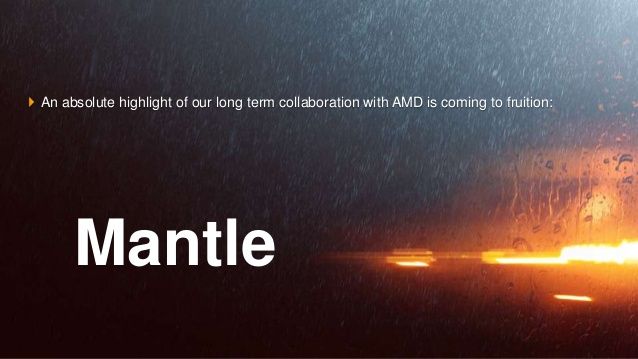
Mantle is a low-level and high performance graphics API for new Radeon GPUs on PC / Windows. It gives a gaming console-like programming model where the developer has a greater control of the GPU and graphics memory with low overhead. Mantle should allow to unlock the graphics potential of Radeon CGN architecture.
Mantle will be used for the first time in an update (December 2013) of the Frostbite 3 gaming engine that powers Battlefield 4.
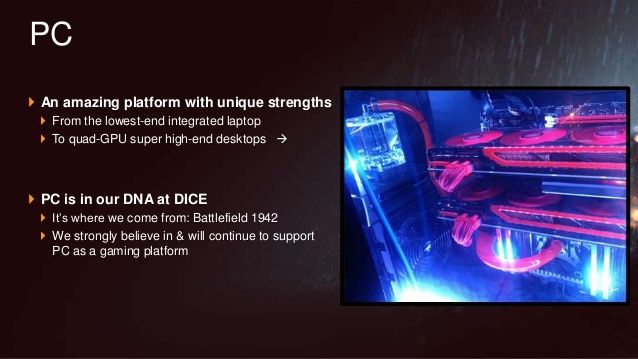
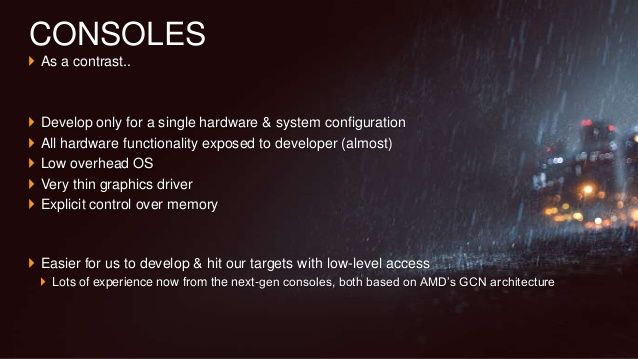
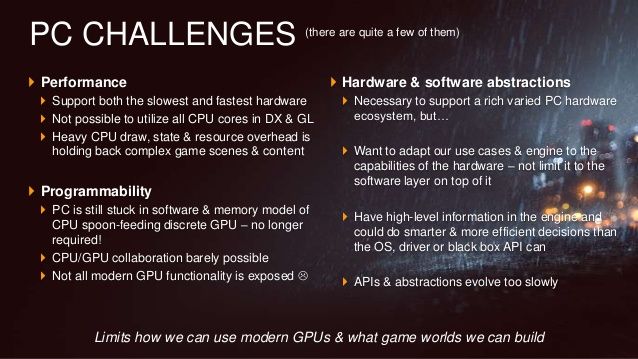
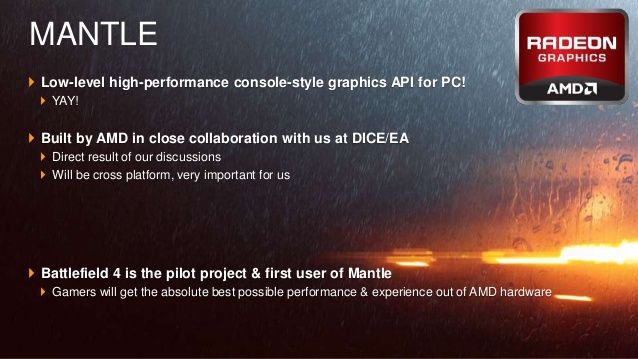
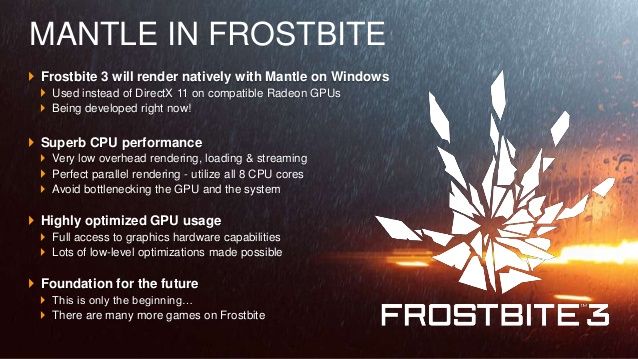
Update (2013.09.27)
Anandtech has published an interestinh article about Mantle: Understanding AMD’s Mantle: A Low-Level Graphics API For GCN.
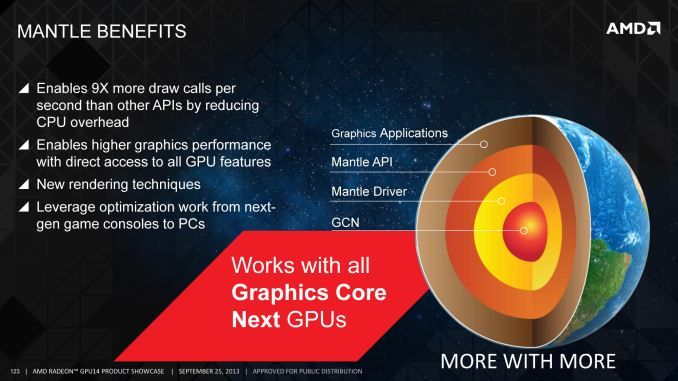
I wonder how it affects DirectX and OpenGL?
“Low-level high-performance console-style” Yay!
Yeah, right. For a lazy developers ™. Remember developer’s nightmare PS3 Cell BE CPU and talk me about console-style blah blah blah. Microsoft and Sony want to forget about “console-style” that’s why PS4 and Xbox One are closer to x86.
Yeah but the level field has slightly changed the majority of game dev people do no longer write game engines themselves they buy in/ use already established ones like Unreal Engine, CryEngine, UniEngine, OGRE or what not. 7 years ago when Xbox360,PS3 launched that was not so much the case.
@RuDyard: the last slide says: “Used instead of DirectX 11 on compatible Radeon GPUs”. Maybe you can code all the rendering stuff with Mantle. You can likely code with Mantle + OpenGL/Direct3D too.
Remember 3dfx Glide or S3 MeTal
@john smith – yes, I remember Glide – optimized OGL directly in hw – first and second gen – amazing speed in comparison to both OpenGL and Direct3D! What killed it? Stagnation. VooDoo3 was still limited to 16bit rendering (with dither 22bit iirc) when Riva TNT2 allowed 32bit. It had many limitations (e.g. texture size) and when VSA-100 finally arrived it still lacked many technologies already implemented in D3D (like hw t&l). Mantle lacks absolutely NOTHING when compared to D3D and won’t… because – just like OpenGL – you can extend it’s functionality as new GPUs arrive. You don’t have to wait for next service pack or windows version. As it’s close to hardware all you need is recent driver with all those features exposed (but standardized too).
With:
a) multiplatform (so no wintel dependent)
b) lowered overhead (it IS important especially when you think of LP x86 or ARM based devices)
c) extended functionality (over recent d3d without add-ons like truform libs decade ago)
d) new gpu features immediate* support
And as for PS3 – developers had no trouble using libgcm, all they had to learn was how to utilize Cell SPEs and it had nothing to do with API. On PC such a thing (expose GPU registers to CPU space) is also possible (I guess something similar is done in Xbox and PS4) but PC has low bandwidth and high latency interconnect with GPU so it’s only viable option to APU. And guess what – it just happens both AMD and Intel start to go in that direction 😉 AMD through common mem (external), Intel through common cache (internal).
Promilus
No, you’re wrong. Glide has been killed because no one wanted to create games using only one API when NVidia and ATI became strong. Also remember DX10.1 only supported by AMD. Couple of games used that “.1” but that’s all. You should compare Mantle with NVidia CUDA. Is it good? Yes. Does someone use it? No. Everyone use OpenCL while CUDA IS BETTER for NVidia but ONLY for NVidia. I believe NVidia can create its own Mantle, but lazy developers will still use DX9.
Promilus
http://store.steampowered.com/hwsurvey
“No, you’re wrong.”
No I’m not. When Unreal (the first one, before UT) was born it was created with modular renderer, however the main focus was for the very best one – Glide API. And it used it extensively so neither OGL nor DX came even close (at the time) in terms of visual quality or performance. The very same thing applies to… Diablo 2 where you can use either D3D, DDraw or Glide and best quality and performance goes to Glide (minor difference but… it is). OGL was supported by ATI, NV, S3 and (limited) 3dfx but didn’t win either despite the support for almost all manufacturers and most OSes. Plus after VooDoo3 3dfx made Glide API open and it didn’t help either. At the time we had already DX7 so while DX evolved from DX5 through 6 to 7 Glide didn’t change a bit. That’s exactly what killed it. Now how it resembles Mantle API? Mantle evolves as GPU evolves. It’s (supposedly) faster than DX and has new features sooner. It’s OPPOSITE to what happened to GLIDE.
“Also remember DX10.1 only supported by AMD”
nothing new – certain shader versions were supported only by NV, other only by AMD. It didn’t matter much unless developers used them to create some effects (remember “soft shadows”? ATI cards had great trouble to handle it properly, same applies to dynamic glow Q3 engine had on Jedi knight series – it hurt ATI performance badly).
“You should compare Mantle with NVidia CUDA. Is it good? Yes. Does someone use it? No. Everyone use OpenCL while CUDA IS BETTER for NVidia but ONLY for NVidia”
Yeah, right… Adobe CS supports CUDA from v4 iirc, most GPU-accelerated raytracers use CUDA. CUDA had plugins to Matlab, Maya and Autocad before AMD OCL GPU implementation finalized 😉
Is it fast? Yes. Is it popular? Yes. Does someone use it? Yes!
OCL is universal and it is the only advantage it has over CUDA.
“I believe NVidia can create its own Mantle, but lazy developers will still use DX9”
https://developer.nvidia.com/nvapi
All your arguments are invalid as you have wrong idea about all those techs.
@Promilus
________$$$$
_______$$__$
_______$___$$
_______$___$$
_______$$___$$
________$____$$
________$$____$$$
_________$$_____$$
_________$$______$$
__________$_______$$
____$$$$$$$________$$
__$$$_______________$$$$$$
_$$____$$$$____________$$$
_$___$$$__$$$____________$$
_$$________$$$____________$
__$$____$$$$$$____________$
__$$$$$$$____$$___________$
__$$_______$$$$___________$
___$$$$$$$$$__$$_________$$
____$________$$$$_____$$$$
____$$____$$$$$$____$$$$$$
_____$$$$$$____$$__$$
_______$_____$$$_$$$
________$$$$$$$$$$
https://dolphin-emu.org/blog/2013/09/26/dolphin-emulator-and-opengl-drivers-hall-fameshame/
AMD can’t do drivers, thats why they need their Glide 2013 API to be competitive.
It would be MUCH better for every one (i believe) to meet together, agree about new api, call it opengl v.5 (with price of breaking backward compatibility) and leave ugly DX far behind. Unrealistic scenario?
“RuDyard says:
2013/09/27 at 07:40
I wonder how it affects DirectX and OpenGL?”
What do you mean? It has nothing to do with them.
@Jarrek
Will NEVER happen, if you know a bit about the politics within the Khronos group.
@Others
I think that making the layer a lot thinner removes also a lot of responsabilities on the driver and graphic API from the chip makers.
The top software layer is a huge burden for them. (OpenGL, DX back end, …)
This result in a simpler and better quality driver and working in all the cases, no more crappy differences and stupid bugs because the system was just too complex to handle all optimal cases, which is a good thing.
On the other hand, think that now all the hard part is left to the devellopers, each company reinventing the wheel…
Dice and a few other can afford that.
I am not sure if many “small” dev would not prefer to stick with DX.
I think it is good of course to see that the raw power should be available to the dev.
But only a few elite with the manpower & money can really use it.
we had one of these
it was called glide
REMEMBER WHAT HAPPENED TO GLIDE.
DirectX and opengl evolved faster and made vendor lock in api’s useless.
http://blogs.windows.com/windows/b/appbuilder/archive/2013/10/14/raising-the-bar-with-direct3d.aspx
“The Xbox One graphics API is “Direct3D 11.x” and the Xbox One hardware provides a superset of Direct3D 11.2 functionality. Other graphics APIs such as OpenGL and AMD’s Mantle are not available on Xbox One.”
Closed proprietary Mantle/Glide 2013 API is DEAD ON ARRIVAL and irrelevant.